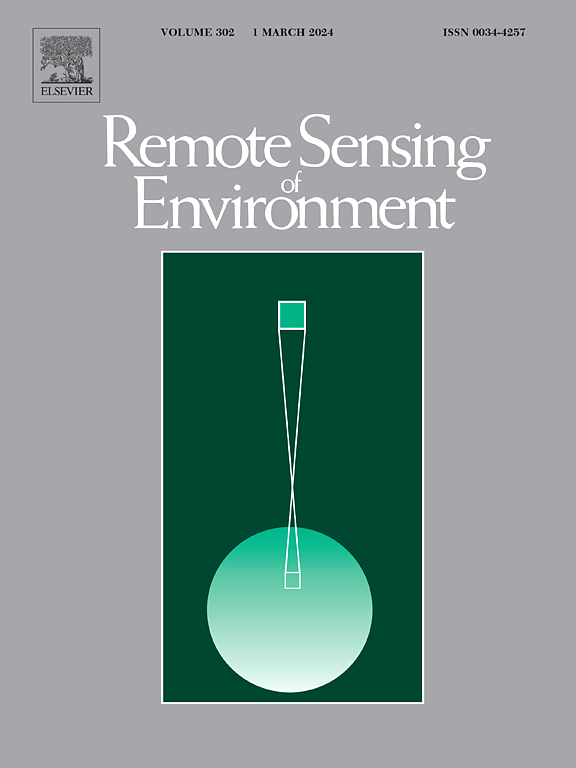从美国不规则协调的Landsat和Sentinel-2时间序列中检测地表物候的基于变压器的模型
IF 11.1
1区 地球科学
Q1 ENVIRONMENTAL SCIENCES
引用次数: 0
摘要
近二十年来,基于卫星植被指数时间序列拟合的传统方法被广泛应用于地表物候研究。然而,这些方法极易受到时间间隙的存在和使用特定的平滑或间隙填充算法的影响。最近有几次尝试使用卷积神经网络(cnn)和循环神经网络(rnn)来检测物候,这些物候产生的不确定性大于三周,大到两个月。此外,这些深度学习方法不能处理时间序列中缺失的数据,并且仍然需要时间间隙填充,这导致物候检测的准确性较低至中等。本研究提出了一种新的基于transformer的模型,用于检测2019年和2020年美国各地的30 m物候事件。具体来说,我们调整了Transformer架构来处理不规则的时间序列,并捕获卫星时间序列中所有高质量观测之间的长期关系。基于transformer的模型使用从高质量LSP产品中提取的参考时间序列样本进行训练,该产品是最近通过融合HLS (Harmonized Landsat和Sentinel-2)观测数据和近地表PhenoCam时间序列(HLS-PhenoCam LSP)产生的。研究了基于变压器的基于两波段增强植被指数(EVI2)的LSP检测模型的准确性,并与最广泛使用的基于混合分段Logistic模型的地表物候检测(HPLM-LSPD)算法和一维CNN模型进行了比较。从基于transformer的模型和HPLM-LSPD算法中检测到的物候模式大多具有可比性,尽管与参考HLS-PhenoCam LSP产品相比,在量级和局部细节方面偶尔存在差异。精度指标表明,基于transformer的模型总体上优于HPLM-LSPD算法和1D-CNN模型,相关系数(R)为0.74 ~ 0.88,平均绝对差(MAD)为9.6 ~ 15天,均方根误差(RMSE)为13.5 ~ 20.6天,平均系统偏差(MSB)为0.7 ~ 4.7天。统计分析还表明,基于transformer的模型在所有植被类型和不同高质量观测数的HLS时间序列上都优于HPLM-LSPD算法。此外,基于transformer的模型的准确性取决于高质量观测的比例。当高质量观测值超过25%时,模型可以保持较高的精度。该研究为从传统方法到机器学习方法检测各种生态系统植被发育物候过渡日期铺平了有效的道路。本文章由计算机程序翻译,如有差异,请以英文原文为准。
A transformer-based model for detecting land surface phenology from the irregular harmonized Landsat and Sentinel-2 time series across the United States
Land surface phenology (LSP) has been widely generated using traditional methods of fitting satellite-based time series of vegetation indices over the past two decades. However, these methods are highly vulnerable to the presence of temporal gaps and the use of specific smoothing or gap-filling algorithms. Several attempts have recently used Convolutional Neural Networks (CNNs) and Recurrent Neural Networks (RNNs) to detect phenology, which produce an uncertainty of larger than three weeks and as large as two months. Further, these deep learning methods cannot handle missing data in time series and still need temporal gap-filling, which results in low to moderate accuracy in phenology detection. This study proposed a novel Transformer-based model to detect 30 m phenological events across the United States for the years 2019 and 2020. Specifically, we adapted the Transformer architecture to handle irregular time series and capture long-range relationships among all high-quality observations in the satellite time series. The Transformer-based model was trained using reference time series samples extracted from the high-quality LSP product, which was recently produced by fusing the HLS (Harmonized Landsat and Sentinel-2) observations with near-surface PhenoCam time series (HLS-PhenoCam LSP). The accuracy of the Transformer-based model for LSP detection using the two-band Enhanced Vegetation Index (EVI2) was investigated and compared with the most widely used Hybrid Piecewise Logistic Model based Land Surface Phenology Detection (HPLM-LSPD) algorithm and one dimensional (1D) CNN model. The phenological patterns detected from the Transformer-based model and the HPLM-LSPD algorithm were mostly comparable, despite the occasional differences in magnitude and local details when compared to the reference HLS-PhenoCam LSP product. The accuracy metrics indicated that the Transformer-based model produced overall higher accuracy than the HPLM-LSPD algorithm and the 1D-CNN model, with a correlation coefficient (R) of 0.74–0.88, a mean absolute difference (MAD) of 9.6–15 days, a root mean squared error (RMSE) of 13.5–20.6 days, and a mean systematic bias (MSB) of 0.7–4.7 days. The statistical analyses also showed that the Transformer-based model outperformed the HPLM-LSPD algorithm across all vegetation types and the HLS time series with different numbers of high-quality observations. Further, the accuracy of the Transformer-based model is contingent upon the proportion of high-quality observations. The model could achieve consistently high accuracy if the high-quality observations exceed 25 %. This study paved an effective way from traditional methodologies to machine learning methods for detecting phenological transition dates of vegetation development across various ecosystems.
求助全文
通过发布文献求助,成功后即可免费获取论文全文。
去求助
来源期刊

Remote Sensing of Environment
环境科学-成像科学与照相技术
CiteScore
25.10
自引率
8.90%
发文量
455
审稿时长
53 days
期刊介绍:
Remote Sensing of Environment (RSE) serves the Earth observation community by disseminating results on the theory, science, applications, and technology that contribute to advancing the field of remote sensing. With a thoroughly interdisciplinary approach, RSE encompasses terrestrial, oceanic, and atmospheric sensing.
The journal emphasizes biophysical and quantitative approaches to remote sensing at local to global scales, covering a diverse range of applications and techniques.
RSE serves as a vital platform for the exchange of knowledge and advancements in the dynamic field of remote sensing.
 求助内容:
求助内容: 应助结果提醒方式:
应助结果提醒方式:


